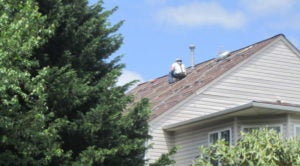Solar racking for different types of roofs

Racking systems keep your solar panels in place. There are a variety of racking and attachment solutions available to match the many different types of roofs. The best racking system for your home depends on how your roof is structured and what type of roofing materials you have. Your installer will recommend the type of racking system most appropriate for your roof.

Most homes in the United States feature roofs that are pitched or tilted. These roofs are typically covered with shingles of various styles and materials. Roofers lay down these shingles in courses (rows) that overlap across your roof to allow water to shed from them and not get underneath and leak into your home.
Panels can be attached to these roofs using aluminum rails that are attached to the singles with flashings that slide under several courses of shingles. The panels are then clamped to the rails to keep them securely in place. Another design has panels attach directly to the flashings themselves. The modules themselves act together as the support system for each other.

Flat/low-slope roofs are usually less than five degrees in tilt. The materials used to cover them vary widely from metal, to modified bitumen to sheet-like covering materials. In addition to the racking systems used in pitched roofs, flat roofs also provide the option of ballasted roofs. These systems use non-penetrating hardware that is kept on your roof by weighted blocks.
Slate can be a difficult material on which to installer solar. Many installers do not work on slate roofs for this reason. In areas where slate is more common, you will find installers who will work on slate roofs themselves or in partnership with a roofing company. Older slate in particular may be too brittle to support solar installation work and may require replacement before installation.
Your solar system should last roughly 30 years, so it is important the roof underneath is in good shape. If your roof is more than 10 years old, you should have it evaluated to determine its remaining lifespan. You may want to consider repairs or replacement prior to installing solar.
